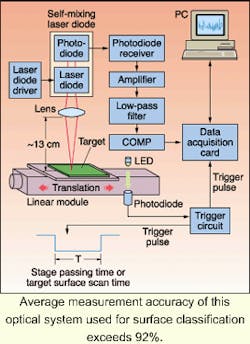Although optical techniques have played a key role in surface-roughness testing for almost a decade, the systems are often complex, bulky, and difficult to align. As a result, they have been slow to infiltrate industrial applications. Now researchers at Shizuoka University (Hamamatsu, Japan) believe they have developed a low-cost alternative based on self-mixing interference in a laser diode that could make optical surface characterization a practical shop-floor tool. Because the only optical components in the system are the laser diode and a lens, the equipment is relatively low cost and compact, as well as easy to align. For eight types of surfaces studied so far, the system's classification accuracy exceeds 92% when it is used in conjunction with an artificial neural network for data processing.
Most work materials, even those that appear smooth, are instead a road map of minute hills and valleys. According to researcher Sahin Kaya Özdemir and colleagues, their optical system characterizes the roughness of these varying surfaces based on the principles of self-mixing laser-diode speckle interferometry. Data analysis begins when the light emitted from the front facet of the laser diode is focused onto a target. As that surface moves transversely through the beam, the scattered fields from every point on the surface illuminated by the light beam add with markedly different phases to produce a speckle interference pattern.
The signal transmitted to the computer is a representation of the light from the laser diode that was reflected from the test surface and scattered back to the laser diode cavity to produce self-mixing interference. The data stream thus depends mainly on the external cavity length and the specific surface characteristics such as texture, reflectivity, and roughness, all of which affect the phase and amplitude of the feedback light.
Key components of the optical system include a semiconductor-laser light source, a graded index lens, an amplifier circuit, a data acquisition card, a trigger circuit, and a personal computer (see figure). The self-mixing laser diode used for speckle velocimetry measurements is an aluminum-gallium-arsenide double-heterojunction device emitting 15 mW at 780 nm.
So far, the Shizuoka scientists have tested their device on at least 11 different samples, including polished and milled aluminum, rubber, black plastic, white plastic, rubber, white and blue paper, cloth-backed sand paper, and washi, a handmade Japanese paper. After performing several experiments at various external cavity lengths, velocities, and driving currents of the laser diode, they identified the optimum processing parameters. These include an external cavity length of approximately 9 to 13 cm, a drive current of 1.5 to 1.9 times the threshold current level of the laser diode, and a translation-stage velocity of 200 to 400 mm/s.
With the low-cost surface-roughness-measurement device, accuracy is limited primarily by the localized irregularities on the surface and the mechanical instabilities of the stage holding the material. The researchers believe that the impact of both may be minimized through future research efforts.
REFERENCE
- S. K. Özdemir et al., Opt. Eng., 4 (1), 38 (January 2001).
About the Author
Paula Noaker Powell
Senior Editor, Laser Focus World
Paula Noaker Powell was a senior editor for Laser Focus World.
